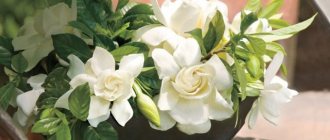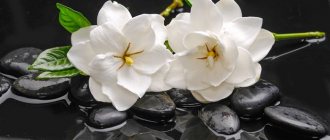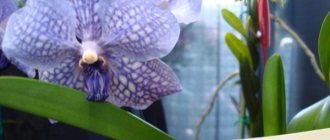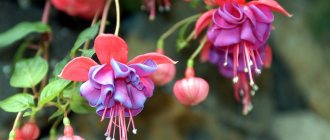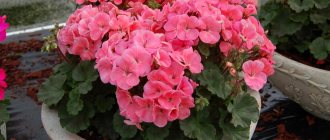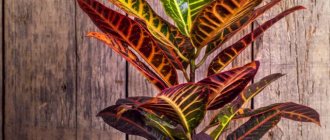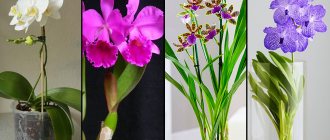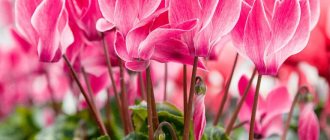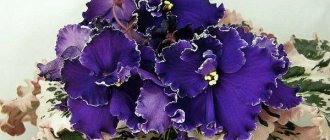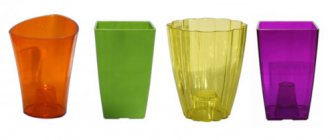When kept in a room, gardenia jasmine can reach a height of 60-80 cm. In the wild, it blooms twice a year, but it will be very difficult for amateur gardeners to achieve a similar result at home. The shoots are smooth and become woody with age. By pinching the tops, you can give your pet any intricate shape.
Home care
Gardenia jasmine not only blooms for a long time, but also exudes a pleasant aroma. You will have to spend some time and effort caring for this snow-white wax flower, as it is very capricious. But the result is worth it.
Location and lighting
Carefully choose the place where the regal gardenia will stand. Eastern or western window sills are best suited for this. Just in front of the windows, dense trees should not grow to block access to light.
If you have to place the flowerpot on a south window, then in the summer at noon you need to lower the blinds or shade the plant with translucent material. Although the plant loves bright light, direct sunlight can leave burns on the leaves and cause them to fall off. In winter, additional illumination with phytolamps is required up to 12 hours of daylight.
During budding, do not move the pot under any circumstances, otherwise the buds may fall off. The angle of light from the lamp should also remain constant.
Do not consider the bedroom as the ward's place of residence. Its strong aroma during flowering can cause headaches in some cases. It is better to keep it in the living room, inhaling a useful and unusual smell.
Temperature
The eastern guest is quite picky about temperature conditions. In spring and autumn, in the room where the flower is kept, it should be +22-24°C during the day, and a little lower at night: +18-20°C. In winter, the intervals on the thermometer should be +17-20°C during the day and at least +16°C at night. Temperatures below +12 degrees are deadly for the bush.
During the budding period, the air should not warm up above +20 degrees, otherwise the plant will direct its energy not to flowering, but to throwing out new branches.
If the pot is in a draft or the room is too dry, the hydrangea will drop its buds.
Watering
In winter, Augusta does not need to be particularly flooded. 2-3 waterings per month will be enough. Starting in mid-March, when buds are actively developing, change your approach to soil moisture. As soon as the top layer begins to dry out, immediately add life-giving moisture.
Pre-settle the water and warm it up a little. You can add a little citric acid or peat to a container of water. If you delay watering, you will notice that the leaves will begin to turn yellow.
Air humidity
Regularly spray the leaves with a spray bottle and the air around the flower. In addition, you can move the flowerpot into a container with wet pebbles. Just make sure that the roots do not come into contact with the water level, otherwise they will rot. Wipe the leaves with a wet rag from time to time.
You can also give your ward a warm shower without touching the buds with a stream of water and covering the ground with polyethylene so as not to wash the substrate. Do this daily. But as soon as the buds begin to bloom, stop the procedure. Otherwise, brown spots will appear on the leaves and flowers.
The soil
If you decide to start a jasmine gardenia, purchase for it a fertile, loose and acidic soil mixture for acidophilic plants. To prepare the soil for planting yourself, mix:
- 25% coniferous land;
- 25% turf land;
- 25% peat;
- 25% sand or perlite.
Don't forget to bake the soil in the oven. Over time, the acidity of the soil will decrease, so raise it to the desired level 2-3 times a month using citric acid (5 drops) and copper sulfate (0.5 g) per 1 liter of water.
Feeding and fertilizers
After transplantation, there is no need to fertilize the soil for two months. In the future, regularly use liquid fertilizer for flowering azaleas. Fertilize the roots once a month, and 2 weeks later, dissolve the fertilizer in water for spraying. This is enough for a whole month.
Once spring and summer are over, stop fertilizing until next spring. This does not apply to young plants. They need feeding throughout the year.
So that your green friend does not need iron, dig two or three rusty nails inside the pot. This is especially true if the leaves suddenly begin to turn yellow.
Transfer
After purchasing a flower in a store, it should be transplanted into a new pot after a couple of weeks. Choose a container 2 cm wider in diameter than the store-bought one. Transfer the bush to a new place without shaking the soil from the roots.
Be sure to cover the bottom of the flowerpot with a layer of drainage, then a layer of river sand with a coarse fraction mixed with charcoal, and then a layer of new soil. After placing the gardenia in a pot, fill the empty spaces with soil mixture and water with warm, settled water.
If you have purchased a flowering bush, do not replant until it has finished blooming, otherwise the representative of the Mirenaceae family will drop its buds and you will not be able to enjoy its beauty.
Mature plants do not like transplanting. So do this as needed approximately once every three to four years, either in early spring before the buds appear, or in the summer after flowering. Having taken the bush out of the old pot, cut off a quarter of the roots, and treat the cut areas with rootstock. After transplanting, place the pot in a bright, warm place.
Trimming
To ensure that hydrangea produces as many side shoots and flower buds as possible, you need to pinch off the young tops. This must be done all the time while the ward is developing, that is, in spring and summer. At the same time, get rid of diseased and weak leaves and dried flowers. If you leave the seeds to ripen, it will take a lot of energy from the flower.
After flowering, do a “general” cleaning, getting rid of excess shoots and forming a beautiful crown. But even shorten all remaining stems by a third of their height. This procedure will allow Cape jasmine to bloom magnificently next year. You don’t have to throw away healthy cuttings, but use them to produce new flowers.
Classification, natural habitat
The botanical classification of gardenia is quite complex and not yet fully formed. The plant belongs to the Rubiaceae family. The Ixoraceae subfamily includes the Gardeniaceae tribe, where the Gardenia genus is listed.
Gardenia (lat. Gardenia) - the genus includes more than 250 species of heat-loving evergreen plants. Many scientists do not agree with this number, and believe that there are only 60 species of real gardenias. These are mostly shrubs, but there are also trees and even thorny vines among them. Representatives of the Gardenia genus live in hot and humid climates - in India, Southeast Asia, southern China, as well as in Africa and the Pacific Islands.
In ornamental plant growing, the popular species is Gardenia jasminoides, or rooting (G. jasminoides JE). The name Gardenia Augusta, i.e. Regal, considered obsolete. Some sources mention G. grandiflora (large-flowered) as a subspecies of Gardenia jasmine.
Gardenia jasminoides
Less commonly found in greenhouses are Golden Gardenia, or Kula (G. Kula), Orange Gardenia (G. citriodora), Vietnamese Gardenia, and others.
Gardenia golden
Appearance
Cape jasmine, as gardenia was called in pre-revolutionary Russia, reaches a maximum height of 1.5 m, and then only in a greenhouse. Indoor gardenia is a compact, round-shaped shrub, reaching half a meter in height and the same amount in width. It can be formed in the form of a bonsai - a dwarf tree.
The leaves are oval or broadly lanceolate, dense and shiny, dark green. Arranged alternately, singly, or in whorls of three. Thanks to its spectacular foliage, gardenia looks attractive even in the absence of flowers. There are variegated forms, for example, the variety Variegata.
Gardenia variegated
Gardenia flowers are 8-13 cm in diameter, single or in clusters of several pieces, double or semi-double. The shape resembles a rose, and the color and aroma resemble jasmine, hence the species name. A newly bloomed flower is snow-white in color and later acquires a golden hue. There are varieties with cream flowers.
Varieties
Home gardenia has a variety of forms and varieties. The period of selection was so long (starting from the 1st century AD) that scientists cannot accurately determine where the natural forms of the plant are and where the artificially created varieties are. The selection was carried out according to the size of the flower and the duration of flowering. As a result, such spectacular varieties as Vetchin, Pleno, and others (Fortuna variety) with 15-centimeter flowers were obtained. Other varieties bloom year-round, such as FourSeasons.
Gardenia varieties are also obtained by grafting. The unpretentious African gardenia thunbergium (G. thunbergium) is often used as a rootstock, and varieties of gardenia jasminoides, Tahitian, or other related species of gardenias are often used as a scion. Only those varieties that, like the rootstock, have a flower with 6 petals (among gardenias there are 5, 6, and 8-petaled forms) are suitable for grafting.
Reproduction
You can increase the number of individuals in your home collection using cuttings, seeds, or dividing the bush into parts. The most difficult thing is to grow a new gardenia from seeds.
Cuttings
It is advisable for beginning flower growers to use this method. As soon as the bush fades, cut the apical cuttings. They must be at least 10 cm in length. It is desirable that each one has a heel - a small woody tip. If there are more than 3-4 leaves on the cutting, you need to get rid of them. Lubricate the cut with activated carbon and treat it with a root growth agent.
You can place the propagation material in cups of water. But it is better to immediately plant it in a moistened soil mixture. Take a plastic container with a lid and slam it shut, planting the cuttings.
Rooting should occur at +25C. Remove the cover from time to time to ventilate and moisten the planting. In about a month, roots will appear. Then the cuttings should be planted in separate flowerpots.
When the shoots reach 15 cm, the tops should be pinched, otherwise side shoots will not be able to develop.
Seeds
The difficulty with this method is that the seed material must be fresh - 2-3 days after collection. But even in this case, do not count on a germination rate of more than 50%. Before planting, treat the seed material with aloe juice, leaving it in it for 4-5 hours. After this, sow in a plastic container with a lid or in any other container, stretching plastic film over the top.
Pre-acidify the substrate. Bury the seeds 5-6 mm, sprinkle with warm water with lemon juice. If necessary, remove the cover or film, ventilate the seedlings and moisten the soil with a spray bottle.
A month later, when shoots appear, move the box to the windowsill, providing bright but diffused light. When the sprouts produce leaves, plant them in separate pots with a diameter of approximately 7.5-10 cm. Pin the sprout that has stretched up to 15 cm.
Seedlings from seeds usually bloom in the second year.
Dividing the bush
During transplantation, carefully examine the roots. Having noticed independent shoots, carefully separate them from each other and plant them in separate flowerpots, placing them strictly in the center. Make sure that the roots do not touch the layer of expanded clay laid on the bottom for drainage.
Cover the sprouts with plastic wrap to create a greenhouse effect. Grow at a temperature of 24 degrees, placing it close to the window, but not on the windowsill itself, protect it from drafts. After a month, you can safely move it to the glass.
Care errors
- If the leaves turn pale, move the flowerpot to a better lit place.
- If blackening occurs, limit exposure to direct sunlight.
- Yellow spots on the leaves require watering with acidified water.
- The falling of buds and leaves indicates improper care of the gardenia.
- Specks on the inflorescences appear due to spraying. This procedure should be stopped before flowering has completely faded.
Diseases and pests
To determine the health of a bush, just look at the appearance of the leaves.
If the leaves of a jasmine gardenia turn black and fall off, check the compactness of the earthen ball in the pot. Perhaps the soil is too loose and the roots are starved of air and nutrients.
The flower can quickly deteriorate due to stagnation of water and excessive fertilizing.
Diseases and possible causes:
- Pale leaves, lack of color, stunted growth - lack of nutrients and low indoor lighting
- Yellow stains on leaf blades - soil is too alkaline
- The flowers have fallen and/or the leaves have drooped - the plant has been exposed to a draft or hypothermia
- The leaves turn yellow and fall off (or fall off for no apparent reason) - the gardenia was watered with too cold water or there was a change in outside air
- The buds have fallen off - perhaps the pot has been moved or the air in the room is too dry
- Whitish leaves – iron deficiency in the soil
Parasites
If all conditions of agricultural technology are scrupulously observed, problems with parasites should not arise. Pests appear only when the plant is weakened by inappropriate care. Weakened gardenia may be attractive to aphids, thrips and mites that react to common insecticides.
- Gray dots on the front surface of the leaf blade indicate thrips infestation
- Leaves rolled into a tube and entangled in a thin web - you are dealing with a mite
- Sticky leaves - the plant is covered with aphids
Before you start growing gardenia at home, carefully study all the details of its maintenance and try to carry them out as accurately as possible. In the past, gardenia was the favorite flower of the European nobility. Along with camellias and rosebuds, men inserted it into their buttonholes, and women collected it into small bouquets. Today, fragrant gardenia flowers are often used to decorate the holiday table.
Folk signs
Gardenia jasmine with its appearance will bring love, tenderness and good mood to the house. She is able to calm the household and set them in a peaceful mood.
If you need to win someone over, grind the leaf into powder and rub it into the skin before the meeting. If you are expecting an important guest, pour a little powder on the threshold so that he will cross.
It is advisable that the newlyweds have gardenias with them. The bride can add a white flower to her bouquet, and the groom can decorate his boutonniere. Decorations like these will bring love to a couple’s home for many years to come.
Medicinal properties
Cape jasmine is not only beautiful, but also very beneficial for health. You can prepare a decoction from the roots and fruits that will help heal tonsillitis, stomatitis, jaundice, and sore throat. You can apply the paste from the fresh plant to a wound or bruise.
You can use it externally, in the form of rinses or lotions, but under no circumstances swallow it, as there is a chance of poisoning.
When working with gardenia, be sure to wear gloves.
If you have free time for care, be sure to plant jasmine gardenias at home. Your home will be decorated with white flowers and will smell like French perfume.
How the gardenia bush blooms
This flower is a shrub whose stems tend to branch. The bark that covers the main stems is distinguished by its brown tint. When growing gardenia at home, it reaches a height of no more than 45–80 cm and grows rather slowly.
The leaves of gardenia are green, glossy, leathery, up to 8 cm long. They have an oblong shape with points towards the base and edge. The surface of each individual leaf is uneven and wavy. The leaves are broadly lanceolate or obovate. The flowers are white or cream, double, semi-double, simple, with a strong aroma. With proper care, the flowering of gardenia is a luxurious sight - the entire bush is covered with large flowers and buds that emit a beautiful aroma.
As you can see in the photo, most types of gardenia, especially those used for home cultivation, have flowers that are somewhat similar to roses:
The main location of the flowers is in the leaf axils, but sometimes they also sprout at the ends of branches. Sometimes inflorescences form, but since the flowers are large, no more than 3 to 5 flowers grow together. The fruit of the plant is a box with pear-shaped or cylindrical seeds. Since it is believed that gardenia blooms from May to August, few people know that if grown correctly, this plant can bloom at any time of the year.
